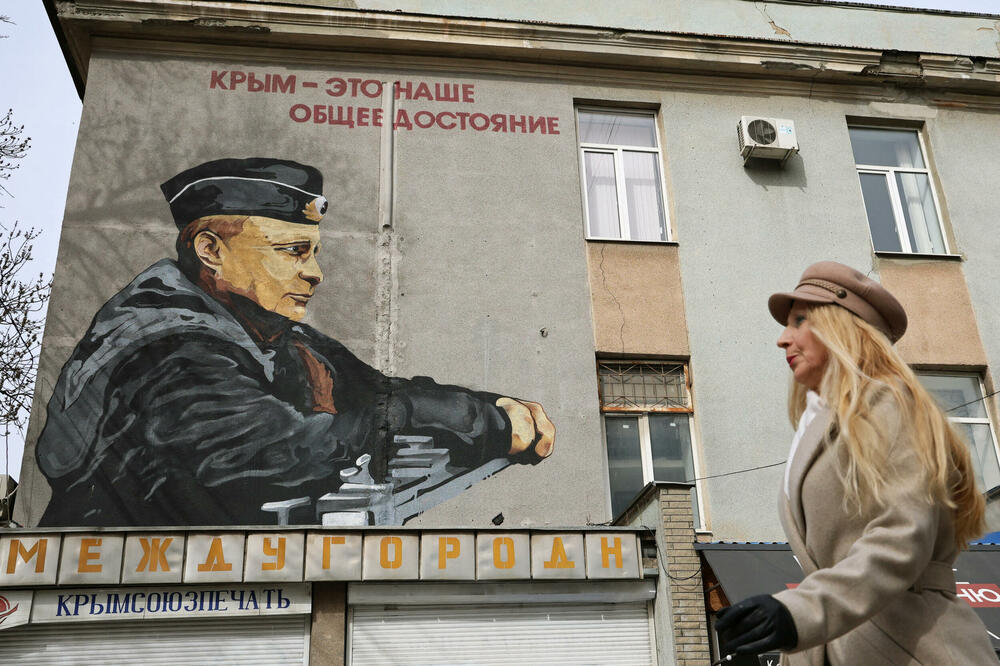When Russia annexed Crimea ten years ago, part of the population protested. Later, many had to flee and some have been fighting in the Ukrainian army ever since. Deutsche Welle (DW) spoke to two people who are fighting for their homeland.
Ten years ago, the Russian Federation occupied and annexed the Ukrainian peninsula of Crimea, forcing thousands of its residents to flee their homes. Some of them, like Isa Akayev and Irina Holosna, joined the Ukrainian forces and have been fighting against the Russian aggressor since 2014.
Return to Crimea after 40 years
Isa Akajev is a 57-year-old man of Crimean Tatar origin. His real name is Nariman Bilyalov, but he is known in Ukraine under a pseudonym. Since 2014, he has been the head of the volunteer battalion "Crimea" at the Ukrainian Armed Forces, which he founded together with other residents of the peninsula. Today it is a special unit within the Ukrainian military intelligence service.
Akayev draws parallels between the current Russian occupation of Crimea and the time when the Soviet authorities deported Crimean Tatars en masse to Central Asia at the end of World War II.
His ancestors, as well as his parents who were children at the time, were deported from Crimea to Uzbekistan in 1944. For the next 40 years, his family lived abroad. Isa Akayev and his sisters were born in the Uzbek Soviet Republic. Their parents told them that their homeland was Crimea and that one day they would return there. This became possible only in 1990, during the collapse of the former Soviet Union.
It was a historic moment, says Akayev. Then it became clear to him that the peninsula should be provided with the support of an independent Ukraine and build its future with it. "We cannot be with Russia. The Russians took everything from us," he emphasizes and explains that the Russians also destroyed the cemeteries and mosques of the Crimean Tatars.
Another loss of homeland
When in the winter of 2014, the first unmarked Russian soldiers in Crimea began to take control of administrative buildings and military facilities, people did not yet understand that this would lead to the occupation of the peninsula, says Akayev.
According to him, in Crimea, after the victory of the pro-European protest movement against the then pro-Russian government in Kiev, they were convinced that there would be resistance and that the intention of the pro-Russian forces would not be realized. He remembers the large demonstrations on February 26, 2014 in Simferopol against the Russian occupation of Crimea. They were organized by Mezhllis, the central executive body of the National Assembly of the Crimean Tatars. Among the participants was Isa Akajev.
At the same time, a pro-Russian rally was held there and a conflict broke out. Two people died in them, and several others were injured. Akayev soon left Crimea and traveled to Kyiv, in order to convince activists there to support the people who remained on the peninsula.
Only later did it become clear to him that there was no turning back for him. His wife called him and begged him not to come back, because unknown persons were already waiting in front of their house. A few days later, his wife and children had to leave Crimea.
A long-prepared annexation
Irina Holosna is one of the pro-Ukrainian residents of Crimea who stayed on the peninsula in 2014 and resisted the occupiers. She has lived in Sevastopol since 1990 and says that even before the annexation, Russian propaganda narratives about the history of Crimea could be heard.
During the rule of the pro-Russian president of Ukraine, Viktor Yanukovych, Russian passports were openly offered to people in Crimea from 2010 to 2014. In return, they were promised new opportunities in Russia, primarily employment, says Holosna.
The inhabitants of Crimea did not perceive it as a threat, she admits: "Nobody had anything against it and it was considered normal. However, in the end, not many people received Russian passports. The Russians were already preparing the annexation in this way and just wanted to test the population ."
When unmarked Russian soldiers came to the peninsula in 2014, Holosna says that together with the wives of Ukrainian soldiers, she went to the barracks at night to stand guard there. In this way, he says, they wanted to prevent the Russians from taking control of those Ukrainian army facilities and ammunition and weapons warehouses.
The desire to liberate Crimea and return
Despite pro-Ukrainian resistance, Russian forces already established control over Crimea in March 2014. Even after the illegal referendum on annexing the peninsula to the Russian Federation, Holosna openly continued to support Ukraine. She points out that none of her relatives and friends in Sevastopol believed in the accuracy of the alleged voting results.
"We didn't accept it and on the way back home on the trolleybus, we loudly sang the Ukrainian national anthem. We thought it would all end soon," Irina recalls sadly.
During the following months, the situation continued to deteriorate. According to Holosna, the teachers started harassing her children at school, and she herself was repeatedly threatened at work because she wore Ukrainian symbols on her clothes.
In September 2014, Irina Holosna left Crimea with her son and daughter. First they went to Lviv in western Ukraine. There she joined the Ukrainian army - it was already resisting Russian-backed separatists in the east of the country. Since then, Holosna has passed many battlefields along the front in the Donetsk region, as well as after the great Russian invasion in 2022. Now, as a member of the aerial reconnaissance unit, she is preparing to go on a combat mission in the south of the country.
Both Isa Akayev and Irina Holosna have been fighting in the Ukrainian army against Russian aggression for ten years. The two want to contribute to the liberation of the peninsula so that they can then return there. Many of their relatives are still in Crimea. Almost the entire Akayev family stayed there. And Holosna in Crimea has her brother's family and grandmother. She is convinced that liberation can only come through military intervention. But she adds that she's sure that won't happen anytime soon.
This feature was previously published in German.
Bonus video:





